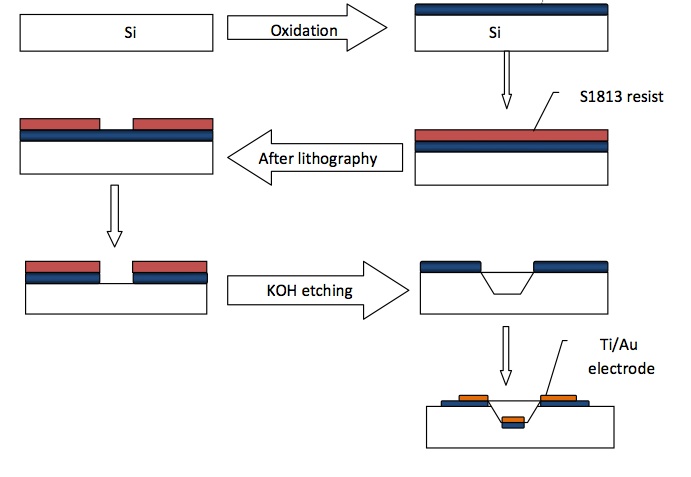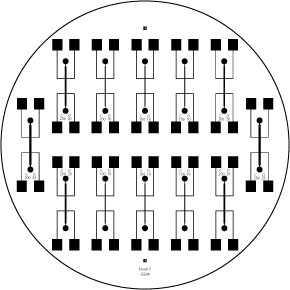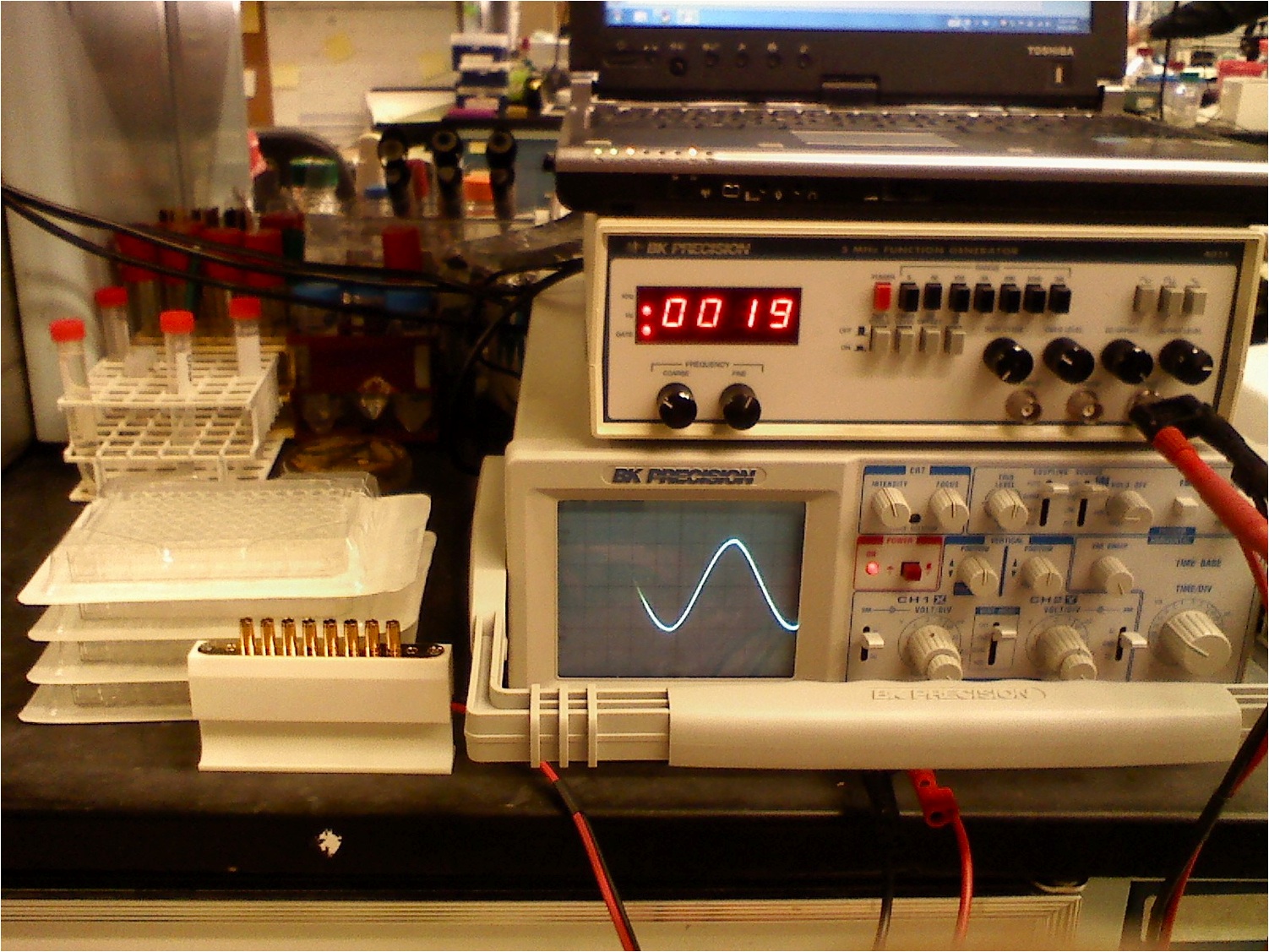Team:Johns Hopkins/Device
From 2010.igem.org
SunPenguin (Talk | contribs) |
SunPenguin (Talk | contribs) |
||
| Line 72: | Line 72: | ||
<br> | <br> | ||
12 Devices are displayed here. Redundancy is important in this process since errors of as little as 5 microns on the aligner, 100rpm when spinning photoresist, or a few seconds in etching solution could easily render a device unusable. There are 2 devices with 300 micron channels (easiest to make), 4 with 200 micron channels (lower odds of success requires more redundancy), and 6 with 100 micron channels (extremely difficult to make). In fact, none of the 100 micron channels worked. In our process, the photoresist that determines the electrode positions is applied to a wafer with channels already present. Since light diffracts if there is any distance between mask and substrate, the size of features pattered at the bottom of channels is distorted. Thus, our electrodes, which were supposed to take the form of two separate columns on either side of the channel, fused across the 100 micron space. | 12 Devices are displayed here. Redundancy is important in this process since errors of as little as 5 microns on the aligner, 100rpm when spinning photoresist, or a few seconds in etching solution could easily render a device unusable. There are 2 devices with 300 micron channels (easiest to make), 4 with 200 micron channels (lower odds of success requires more redundancy), and 6 with 100 micron channels (extremely difficult to make). In fact, none of the 100 micron channels worked. In our process, the photoresist that determines the electrode positions is applied to a wafer with channels already present. Since light diffracts if there is any distance between mask and substrate, the size of features pattered at the bottom of channels is distorted. Thus, our electrodes, which were supposed to take the form of two separate columns on either side of the channel, fused across the 100 micron space. | ||
| + | |||
| + | =='''Instrumentation'''== | ||
| + | We tried several approaches to electrostimulate our cells with both accuracy and precision, but without widespread cell death. Our approaches are detailed below.<br><br> | ||
| + | '''A Microfluidic Chip:'''<br> | ||
| + | {| | ||
| + | |[[Image:Mask.jpeg|400px|thumb|This is a schematic representation of the mask used for the fabrication of our ill-fated microfluidic device.]] | ||
| + | || | ||
| + | *Consists of 300 micron-wide channels with titanium and gold electrodes to electrically stimulate the cells. | ||
| + | **This approach would allow for great precision and accuracy in electrostimulation, because each cell could be treated with exactly the same electric field. | ||
| + | **This approach would also allow for high throughput quantitation without high cell volumes (and the associated reagent, media, and time concerns), by virtue of its own low volume. | ||
| + | *We completed the fabrication of this device and are currently perfecting the fabrication technique to improve device quality and performance. | ||
| + | **Microfluidic fabrication is extremely challenging and costly and, for those reasons, we were forced to abandon this approach. | ||
| + | *For further information about our construction and techniques, see our [[Team:Johns_Hopkins/Device#Device Design|fabrication protocol]]. | ||
| + | |} | ||
| + | |||
| + | '''A homemade, aluminum foil-based electrode:'''<br> | ||
| + | Suffice it to say that this device was sufficient for initial, qualitative tests but did not provide the consistency or usability for effective long-term use. Essentially, the device was 8 well plate with aluminum electrodes with a brass backing. This design was quickly abandoned. | ||
| + | |||
| + | '''An 8 well, gold-plated electrode:'''<br> | ||
| + | {| | ||
| + | |[[Image:Hightp.jpeg|500px|thumb|This is a quick photo of our delightfully multidiciplinary final setup. As noted in the text to the left, it includes the electroporator, a 96 well plate, the function generator, and our oscilloscope. Click for a high resolution version.]] | ||
| + | ||Finally, we have started using a gold-plated coaxial 8 well electroporater to electrically stimulate the cells. It has shown excellent results and allows us to do large scale experimentation using 96 well plates. In the image to the left, you can see our complete and final setup. | ||
| + | *In the bottom left, the 96 well plates where we kept our cells. These 96 well plates also fit into flourometer and spectrophotometer we used to quantify our cells' response. | ||
| + | *Also in the bottom left, our 8 well gold-plated coaxial electroporator. The electroporator fits neatly into a vertical column of our 96 well plate, allowing us to easily subject multiple conditions (i.e. with and without vesicles) to identical conditions, or to run a particular condition in up to 8-fold multiplicity. | ||
| + | *On the lower right, the oscilloscope that shows the alternating current produced by the function generator | ||
| + | *In the middle right, the function generator we used to produce the voltage that induced our cells. In this image, it is set to 19 Hz alternating current. | ||
| + | |} | ||
Revision as of 22:58, 27 October 2010
Device Design
Microfluidics
Protocol for creating silicon channels with metal electrodes
- We grow an oxide mask. The Si wafers are put into an oxidation furnace to grow a layer of SiO2 that’s about 200 nm thick so that it can be used as a mask for the etching of Si in KOH. Water vapor is used to oxidize the Si and the oxidation temperature is 1100 C.
- We then use photolithography to pattern the channels into the silicone wafer. We use a mask and positive resist S1813, coating with a spin at 3500 rpm for a minute to get about 1.2 um layer. Then we bake the wafer at 95C for 2 minutes. The wafer is then exposed to 100mj/cm/cm of UV radiation and then developed in developer CD26 for about a minute. This is followed by a DI water rinse then it is dried.
- We then etch the oxide mask using buffered HF or BOE solutions, in which the etching rate is about 80nm/min.
- The resist is then removed by spraying acetone onto the resist followed by IPA to wash away acetone.
- The fluidic channels are then etched into the Silicone wafer using heated KOH, in which the etching time depends on the desired depth of the channels. The etching rate is about 0.5 micron per minute at 70C. We had etching times of 40 minutes for 20 micron deep channels.
- The remaining oxide is then removed in BOE solution.
- We then grow another layer of oxide on the wafer to electrically isolate the metal electrodes and the substrate.
- We then apply the same photolithography technique described in step 2 to define the electrodes on the wafer. We use mask and a thicker layer of photo resist this time because of the topology of the wafer.
- We then deposit Au on the silicone wafer using an electron beam evaporator. This results in a uniform 100 nm thick layer of Au on the wafer.
- We then remove the resist in acetone then IPA.
- Finally we use photolithography to remove the unwanted oxide, using a third mask.
- A glass slide is then drilled using special ultrahard drill bits, such that the holes are aligned with the inlet and outlet of the microfluidic chip.
- These glass slides are the bonded to the silicone wafer and the device is ready for use.
The process:
An overlay of our electrode and channel masks is show below.
12 Devices are displayed here. Redundancy is important in this process since errors of as little as 5 microns on the aligner, 100rpm when spinning photoresist, or a few seconds in etching solution could easily render a device unusable. There are 2 devices with 300 micron channels (easiest to make), 4 with 200 micron channels (lower odds of success requires more redundancy), and 6 with 100 micron channels (extremely difficult to make). In fact, none of the 100 micron channels worked. In our process, the photoresist that determines the electrode positions is applied to a wafer with channels already present. Since light diffracts if there is any distance between mask and substrate, the size of features pattered at the bottom of channels is distorted. Thus, our electrodes, which were supposed to take the form of two separate columns on either side of the channel, fused across the 100 micron space.
Instrumentation
We tried several approaches to electrostimulate our cells with both accuracy and precision, but without widespread cell death. Our approaches are detailed below.
A Microfluidic Chip:
|
A homemade, aluminum foil-based electrode:
Suffice it to say that this device was sufficient for initial, qualitative tests but did not provide the consistency or usability for effective long-term use. Essentially, the device was 8 well plate with aluminum electrodes with a brass backing. This design was quickly abandoned.
An 8 well, gold-plated electrode:
Finally, we have started using a gold-plated coaxial 8 well electroporater to electrically stimulate the cells. It has shown excellent results and allows us to do large scale experimentation using 96 well plates. In the image to the left, you can see our complete and final setup.
|
 "
"



